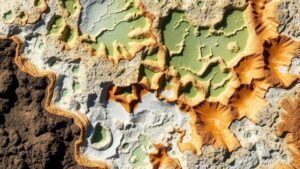Prospecting for Silver in Carbonate-Hosted Epithermal Systems
Introduction to Carbonate-Hosted Epithermal Systems
Carbonate-hosted epithermal systems represent a significant and lucrative realm of exploration in the mining industry, particularly for silver. As geologists and prospectors delve into these systems, understanding their formation, mineralization, and exploration methodologies can enhance the potential for successful prospecting endeavors.
The Formation of Carbonate-Hosted Epithermal Systems
Carbonate-hosted epithermal systems are geological environments characterized by a combination of volcanic and sedimentary processes. These systems typically form at moderate depths (around 300 to 1,000 meters) and are typically associated with tectonic activity. mineral deposits evolve from hydrothermal fluids originating from volcanic magma, which interact with carbonate rock formations.
Key Geological Indicators
Several geological indicators signal the presence of carbonate-hosted epithermal systems, including:
- Presence of hydrothermal alteration zones
- Significant structures such as faults and fractures
- Unusual mineral assemblages, often including silver, lead, and zinc
These indicators are crucial for prospectors to identify promising sites for exploration and development.
Mineralization Processes
The mineralization in carbonate-hosted epithermal systems occurs through a combination of physical and chemical processes. Silver typically occurs in the form of argentite or electrum within these systems, often alongside lead, copper, and zinc minerals.
Fluid Dynamics and Reaction Mechanisms
Hydrothermal fluids, rich in metal ions, ascend through fractures and permeable rock layers. As these fluids encounter cooler temperatures, they precipitate silver and other metals. Key reaction mechanisms include:
- Destabilization of metal complexes
- Temperature and pressure changes
- pH shifts often induced by dissolution of minerals
Understanding these processes is essential for geologists to predict the potential distribution of mineral resources.
Exploration Techniques
Successful prospecting in carbonate-hosted epithermal systems relies on various exploration techniques that combine advanced technology with traditional methods.
Geological Mapping and Sampling
Geological mapping is an initial step in identifying potential silver-bearing zones. By analyzing rock types, structures, and alteration patterns, prospectors can pinpoint areas with a higher likelihood of mineralization. Sampling techniques include:
- Surface rock samples to assess mineral content
- Soil geochemistry for detecting metal anomalies
Geophysical Methods
Geophysical methods such as electrical resistivity and induced polarization can further refine exploration efforts by identifying subsurface features indicative of mineralization. For example, areas with higher resistivity may point to the presence of carbonate rocks, while lower resistivity zones may indicate mineralization.
Case Studies: Successful Prospecting Examples
A prime example of successful silver prospecting in carbonate-hosted epithermal systems can be observed in the San Jose Mine in Mexico. The mine utilizes a combination of geological mapping, soil sampling, and state-of-the-art geophysical methods that have resulted in significant silver production rates.
Another notable example is the Silver Valley district in Idaho, where the presence of extensive mineralized veins within carbonate formations has contributed to its reputation as one of the richest silver-producing areas in the United States. The integration of geochemical techniques led to the discovery of previously overlooked deposits.
Challenges and Opportunities
While the potential for discovering silver in carbonate-hosted epithermal systems is substantial, prospectors face challenges such as high competition, regulatory issues, and fluctuating market prices.
Mitigating Risks
To overcome these challenges, prospectors can:
- Incorporate advanced technology such as drone surveys and 3D geological modeling to improve efficiency
- Stay informed on regulatory changes and develop strong relationships with local governments
Conclusion: The Future of Silver Exploration
Prospecting for silver in carbonate-hosted epithermal systems presents a dynamic and promising field for geologists and mining companies alike. As exploration techniques continue to advance, and with a deeper understanding of geological processes, the potential for significant silver discoveries remains strong. Ongoing technological improvements and adaptive strategies will be vital in navigating the complexities of this lucrative endeavor.


